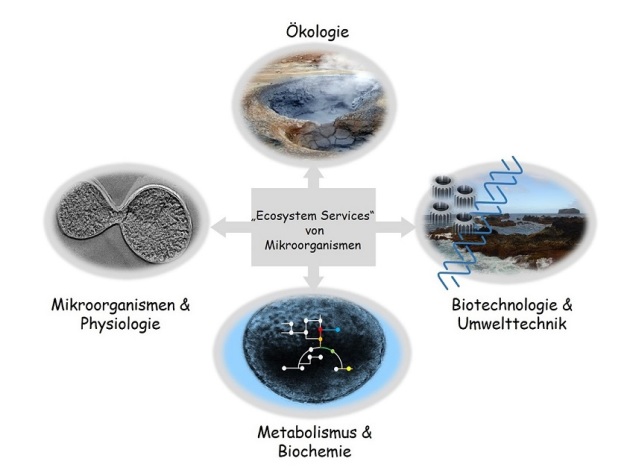The structure of EMB

Environmental Microbiology and Biotechnology
The EMB is a department of the Faculty of Chemistry and the core subject of the Bachelor's/Master's degree course in Water Science. With the research groups of Prof. Bettina Siebers (appointed in 2008) and Prof. Rainer Meckenstock (2014) and Prof. Alexander Probst (2018), the Biofilm Centre has developed into a competence centre for environmental microbiology in recent years.
The aim of the EMB is to understand the ecology and biochemical basis of microbial processes in the environment. The combination of know-how from chemistry such as Raman microscopy, nanoparticles and mass spectrometry with modern biological methods of e.g. genomics and transcriptomics enables the three research groups to open up new research areas in microbiology.
Our research topics range from groundwater and drinking water production to extreme habitats such as oil reservoirs or hot springs where archaeae dominate. Based on the understanding of basic processes, new biotechnology is developed, ranging from water treatment and remediation of contaminated sites to enzyme production and development of new strains ("metabolic engineering"), e.g. for the production of biotechnologically relevant products and process optimization.

In environmental microbiology and biotechnology four main topics are addressed (Figure 1):
Ecology and environmental processes: We investigate the composition and dynamics of microbial systems and unravel environmental processes underground. To do so, we go into the field and take samples e.g. from the cold water geyser in Andernach, contaminated groundwater in Düsseldorf or the world's largest tar lake in Trinidad and Tobago. Using the latest methods of genome-resolving metagenomics and amplicon sequencing, environmental samples are analysed for their microbial composition. We are also developing new isotope analysis methods such as reverse isotope labelling, which can be used to very sensitively measure activities and processes in environmental samples. Furthermore, new methods are being developed to observe processes on the single cell level that cannot be observed in a population or on a larger scale. These include Raman microscopy or "single cell sequencing" (Probst, Meckenstock).
Physiology: The organisms involved are isolated and characterised (Meckenstock, Probst). Here, the physiology of the microorganisms is studied in detail, which forms the basis for the diverse processes in the environment. Furthermore, these degradation processes are investigated directly in the environment. Important here is also the growth of microorganisms in biofilms and the consequences of the sessile lifestyle on microbial processes (Wingender).
Biochemistry: In order to understand the biochemistry of these processes in detail, interesting metabolic pathways and their regulation are investigated (Siebers, Meckenstock). Here, both the central metabolism of archaeae and biochemical degradation pathways, e.g. of pollutants, are studied up to the molecular basis and regulation at the gene and protein level. At the ecosystem level, biochemical metabolic processes are also predicted based on genomics and transcriptomics in order to put biochemistry in relation to the ecosystem.
Biotechnology: Building on basic knowledge in the fields of ecology, physiology and biochemistry, new biotechnological processes are being developed in order to use new enzymes or synthetic strains biotechnologically on the one hand and to develop processes for the degradation of pollutants in the environment on the other (Siebers, Meckenstock).
